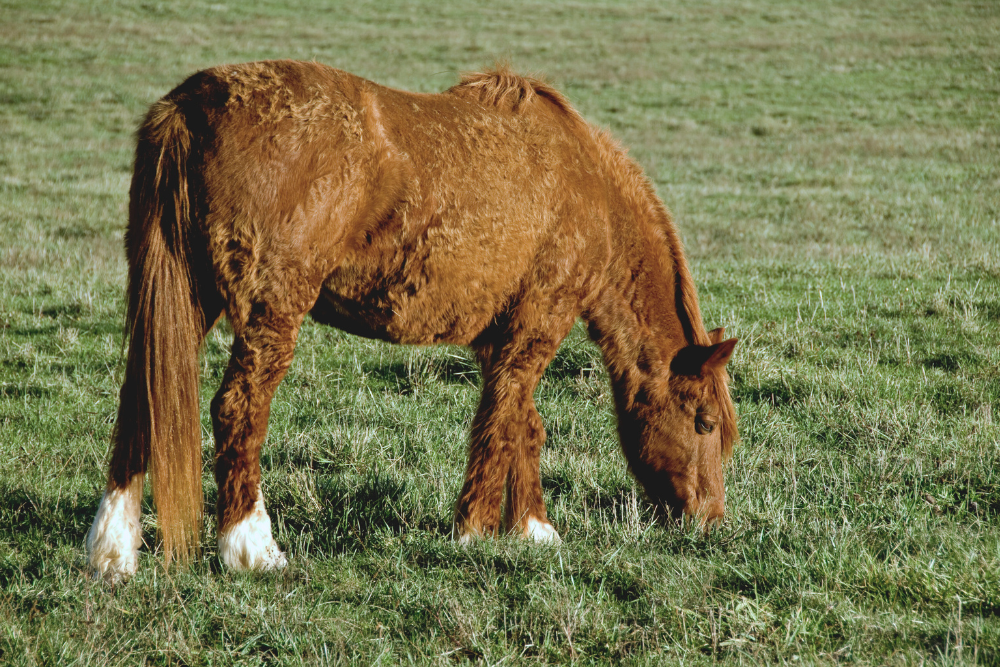Pars Pituitary Intermedia Dysfunction (PPID)

Written by Briony Witherow MSc RNutr. FHEA
Pars Pituitary Intermedia Dysfunction (PPID) What is it?
Formerly known as Cushing’s disease, Pars Pituitary Intermedia Dysfunction (PPID) is a chronic progressive disease (age-related), common in older horses. The change in terminology was deemed necessary due to the differing development of the disease between horses and dogs and humans which shared the same term. Research estimates that around 20% of horses and ponies over the age of 15 are affected, with prevalence increasing further with each year of age.
PPID affects the pituitary gland which is responsible for secreting hormones throughout the body. This action is controlled by the hypothalamus, which generates releasing and inhibiting factors, stimulating or inhibiting secretion of pituitary hormones. The pituitary gland is comprised of three lobes, one of which is called the pars intermedia which is the key area affected in horses with PPID. In horses with PPID neurons here undergo progressive degeneration leading to decreased production of dopamine (responsible for regulation on hormone production) resulting in hypertrophy (enlargement) of the pars intermedia and an over-production of pituitary hormones, such as adrenocorticotrophic hormone (ACTH).
Common signs and symptoms
The most common symptom associated with PPID (and arguably the easiest to spot) is a long or curly coat which does not shed fully, this is often accompanied by excessive drinking and urination and recurrent or unexplained laminitis. PPID is associated with an increased risk of laminitis, research suggesting an increased risk of between 50-80%.
Other key clinical signs are noted below:
- Hypertrichosis/ hirsutism (excessive growth of long and sometimes curly coat)
- Lethargy
- Loss of appetite
- Weight loss
- Loss of topline (muscle) which can result in a pot-bellied appearance with increased abnormal fat distribution (above the eyes, over the crest and above the tailhead)
- Recurrent or seemingly unexplained laminitis
- Hyperhidrosis (excessive sweating)
- Polydipsia (excessive drinking)
- Polyuria (excessive urination)
- Increased susceptibility to chronic infections, dental disease, hoof abscesses, skin infections and parasitic burdens.
Diagnosis is often prompted by clinical signs and symptoms and can be undertaken through blood tests which look at baseline or dynamic levels of ACTH and/or cortisol in the blood. Interpretation of this can be complicated by seasonal changes in ACTH; as daylight hours decrease, ACTH increases, meaning different reference values are required to adjust for this. As we have developed our understanding of these seasonal changes, this has revealed a testing period in the Autumn where the detection of ACTH abnormality is particularly sensitive. As such, for those with borderline test results, retesting in the Autumn is often recommended.
How can we support horses with PPID?
General management for horses diagnosed with PPID includes clipping and grooming to moderate risk of skin disease from changes in coat growth/shedding along with extra care and attention with vaccinations, worming, dental and hoof care.
From a nutritional standpoint the diet should be based around a suitable forage source which is low in starch and sugar (ideally <10% water soluble carbohydrates) and low starch and sugar bucket feed (again <10% starch and sugar combined (non-structural carbohydrate). For good doers, a balancer or broad spectrum vitamin and mineral supplement is typically suitable.
For poorer doers, aiming for a higher calorie bucket feed which sources calories from fibre and oil is ideal (the latter only where concurrent kidney and liver issues are absent).
Medication called Pergolide (brand name Prascend) is often recommended for those diagnosed with PPID which can help counteract the loss of dopamine receptors in the hypothalamus. This helps to normalise the overproduction of hormones like ACTH which in turn helps to reduce the severity and occurrence of signs and symptoms.
Additional supplementation such as antioxidants (vitamin E and C) may be of benefit for horses with PPID. Herbal supplements such as Chasteberry (Vitex agnus-castus) which is thought to increase dopaminergic activity can be fed and anecdotally work as part of a holistic approach, however, there appears to be much variation in active substance levels and more research is required to establish best practice recommendations.
Take home message
- PPID is a slow-progressing disease that can be easily recognised, diagnosed and treated.
- Recommended action includes a combination of general and feed management alongside veterinary recommended treatment as required.
- Treatment is often very successful when instigated early on.
Don't forget to check out our latest product Corticosal from Navalis. To support the metabolism of horses with PPID With monk's pepper, ginkgo and artichoke. Corticosal is suitable for feeding alone or as a supplement to other therapeutic measures.

1 comment
My cob x mare was diagnosed at age 11 so typically not the older horse. Rosa had several unexplained colic episodes and tested for stomach ulcers initially beforehand. She has always been a good doer and management of her weight continues to be difficult and a constant worry. Now aged 22 Rosa remains on restricted grazing a low calorie diet and soaked hay. Yearly dental checks as well as strict worming. One episode of severe laminitis 3 years ago. With the help of a great vet Rosa recovered and lives a happy life.